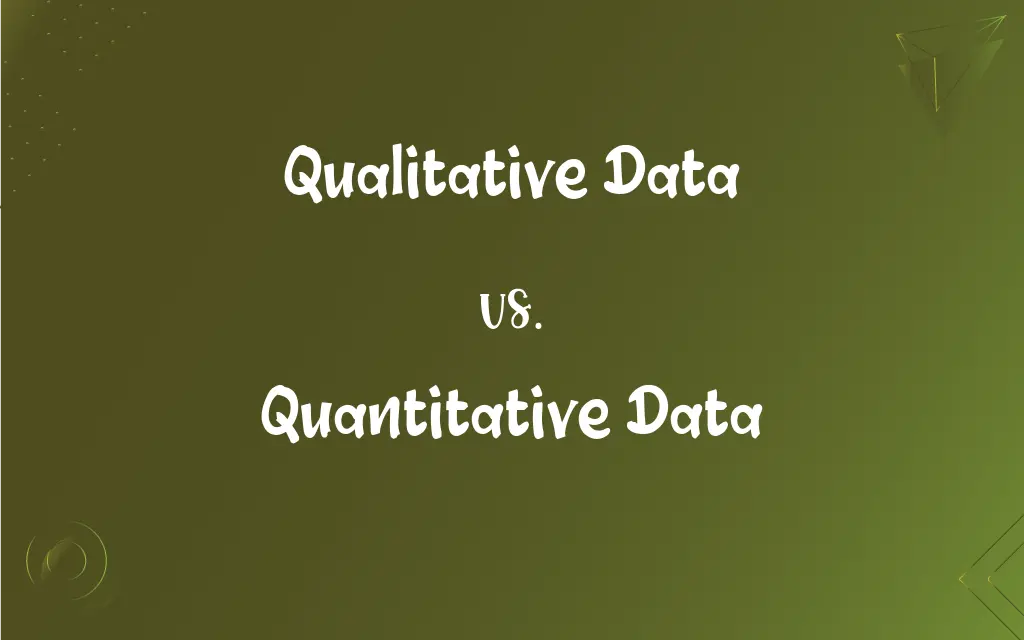Qualitative Data vs. Quantitative Data: What's the Difference?
Edited by Aimie Carlson || By Harlon Moss || Updated on October 13, 2023
Qualitative data is descriptive and concerns characteristics, while quantitative data is numerical and can be measured.

Key Differences
Qualitative data and quantitative data are fundamental concepts in research, addressing different types of information. Their distinction helps in understanding and interpreting research findings, thereby adding depth and breadth to studies.
Qualitative data is primarily descriptive, emphasizing subjective experiences, perceptions, and interpretations. It seeks to understand the "how" and "why" behind behaviors, attitudes, and patterns. This data often emerges from open-ended questions, interviews, or observations, presenting a detailed picture of the topic at hand.
On the other side, quantitative data offers numerical insights, focusing on the "how many" or "how much" aspect. It's based on measurable information and usually comes from closed-ended questions or structured research tools, like surveys and experiments. This type of data is more objective and can be subjected to statistical analyses, providing a basis for patterns, comparisons, and predictions.
While both qualitative data and quantitative data serve valuable purposes, they have different analysis methods. Qualitative analysis is interpretative and often seeks patterns or themes, while quantitative analysis uses statistics and numerical comparisons. In many research endeavors, a combination of both data types can offer a comprehensive understanding of a subject.
Comparison Chart
Nature
Descriptive
Numerical
ADVERTISEMENT
Focus
Subjective experiences, perceptions
Measurable quantities
Collection Methods
Interviews, observations, open-ended questions
Surveys, experiments, closed-ended questions
Analysis
Thematic or pattern-based
Statistical
Example
Feelings, beliefs, descriptions
Percentages, averages, frequencies
Qualitative Data and Quantitative Data Definitions
Qualitative Data
Qualitative data focuses on the depth of information rather than its quantity.
The detailed feedback from the focus group session was a valuable source of qualitative data for the team.
ADVERTISEMENT
Quantitative Data
Quantitative data is typically gathered using structured research methods.
Using a standardized test, researchers obtained quantitative data on students' math skills.
Qualitative Data
Qualitative data pertains to descriptions and characteristics that can't be easily measured.
The patient's feelings and thoughts about the treatment were gathered as qualitative data.
Quantitative Data
Quantitative data emphasizes the quantity of information and its objectivity.
The annual report presented quantitative data on the company's financial growth over the past year.
Qualitative Data
Qualitative data captures the essence of attributes, properties, and descriptors.
Interviews with customers provided rich qualitative data on their experiences with the product.
Quantitative Data
Quantitative data consists of measurable numbers and statistics.
The survey resulted in quantitative data showing that 75% of respondents preferred the new design.
Qualitative Data
Qualitative data is often collected through methods like open-ended interviews or observations.
By observing classroom interactions, the researcher gathered qualitative data on student engagement.
Quantitative Data
Quantitative data is used for numerical comparisons and making predictions.
The company collected quantitative data on monthly sales to forecast future profits.
Qualitative Data
Qualitative data is interpretative and delves into understanding behaviors, motivations, and patterns.
Through stories and personal narratives, qualitative data was collected on the impacts of the policy change.
Quantitative Data
Quantitative data can be subjected to various statistical analyses.
The quantitative data from the experiment was analyzed to determine the average response time.
FAQs
How do you pronounce "qualitative"?
“Qualitative” is pronounced as [KWOL-i-tey-tiv].
Can qualitative data be measured?
No, qualitative data is descriptive and cannot be measured in numerical terms.
What is qualitative data?
Qualitative data describes non-numerical information that relates to properties, qualities, and characteristics.
How is qualitative data gathered?
Through observations, interviews, or analysis of texts and objects.
How is “qualitative data” spelled?
Q-U-A-L-I-T-A-T-I-V-E D-A-T-A.
Can quantitative data be measured?
Yes, quantitative data is numerical and can be measured and analyzed mathematically.
Can quantitative data describe quality?
No, quantitative data is numerical and does not describe qualities or characteristics.
Is quantitative data objective?
It tends to be objective as it relies on numerical measurements.
Can qualitative data be converted to quantitative data?
In some instances, qualitative data can be categorized and counted, making it quantitative.
Give an example of qualitative data.
An example is the color of a car.
Is qualitative data subjective?
It can be subjective as it often involves categorization based on qualities.
What is quantitative data?
Quantitative data represents numerical information that can be measured and quantified.
How is quantitative data gathered?
Through measurements, surveys, or any method that produces numerical results.
What fields commonly use quantitative data?
Sciences, finance, and any field requiring statistical analysis often use quantitative data.
Can quantitative data be visualized?
Yes, it can be visualized through graphs, charts, and tables.
What fields commonly use qualitative data?
Social sciences, humanities, and marketing often use qualitative data.
Is qualitative data valuable in research?
Yes, qualitative data provides depth and context to research findings.
How do you pronounce “quantitative”?
“Quantitative” is pronounced as [KWON-ti-tey-tiv].
Give an example of quantitative data.
An example is the height of a person, such as 5.6 feet.
How is “quantitative data” spelled?
Q-U-A-N-T-I-T-A-T-I-V-E D-A-T-A.
About Author
Written by
Harlon MossHarlon is a seasoned quality moderator and accomplished content writer for Difference Wiki. An alumnus of the prestigious University of California, he earned his degree in Computer Science. Leveraging his academic background, Harlon brings a meticulous and informed perspective to his work, ensuring content accuracy and excellence.
Edited by
Aimie CarlsonAimie Carlson, holding a master's degree in English literature, is a fervent English language enthusiast. She lends her writing talents to Difference Wiki, a prominent website that specializes in comparisons, offering readers insightful analyses that both captivate and inform.
































































